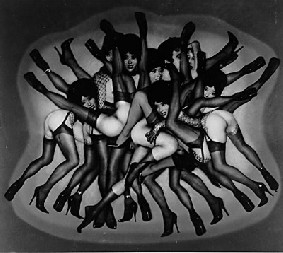Mad Love
John Haberin New York City
Pierre Molinier
I caught a show that is far more outrageous than my reviews will ever be. I am no longer in shock, but I have lost only a little of its power.
Pierre Molinier, born in 1900, was a minor painter (although, I admit, I am judging solely by my never having seen his paintings to this day) when in 1955 Andre Breton gave him a show. Neither could have foreseen that Molinier was only just about to become a Surrealist in deadly earnest. In his 60s he let loose an astonishing series of sexually charged photographs. 
I have been told my head is screwed on backward, but these black-and-white photomontages give new meaning to the phrase. Faces and buttocks confront the camera together, attached to a single body, pressed together uncomfortably but enough at ease to close in on the picture frame. Naked limbs come at you from all sides, as if the human form were unable to keep from fanning out wildly, the black silk of S&M apparently the only thing keeping these creatures from flying apart even more painfully.
I gather than most of the women are really Molinier, tempting himself as much as seducing the viewer's own obsessions. In one series he claims to be screwing himself. Had he written that in English, perhaps "screwing" would be only a reasonable word for these desperately cobbled together beings. Decades before, Breton had called his classic novel of Surrealism Mad Love, but the phrase never sounded so dangerous.
A book on Molinier is called A Life in Hell, and certainly the imagined creatures echo at least one of Dante's lower regions and Rimbaud's lyrical despair. That one-sided view, however, cannot suggest the wit and energy and these works. A photomontage is basically a visual pun, and Molinier's anticipate the postmodern constructions of Cindy Sherman, Aneta Grzeszykowska, Lucas Samaras, or some parts of gay culture. But this is nothing as knowing and retrospective as Sherman's re-creation of film noir. This is how he wished to live.
The frightening sincerity of these photos obviously cannot be part of life for someone like me, who sees sex only figuratively as a tormented masquerade. So long as it cannot, I still have a little trouble thinking of Molinier as so major a "find," but he will not let go of me easily either. If Dada marginalized women and Surrealism all but excluded them, here the woman returns—as a man. If de Sade becomes a theme for artists like Nayland Blake today, never does the irony bite so hard.
I am reminded of the relationship, pointed out by Hal Foster, between Surrealism and the Freudian death wish. One photograph in fact shows a cross above his "tombe fictive." I am also reminded that for Freud the death wish is a desire as well as a compulsion, a desire as powerful as eroticism. It must have been so for Molinier as well. He committed suicide in 1976.

Pierre Molinier's photographs ran though September 14, 1996, at Ubu in conjunction with Wooster Gardens in Soho. I refer to Hal Foster's wonderful Compulsive Beauty.




